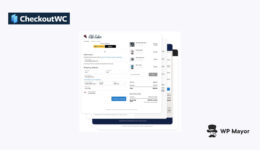How To Sell Digital Art Online (and Avoid the Algorithm Abyss)

In the not-so-distant past, the only way for creators to get their art into fans’ hands —and cash into their pockets —was to sell at galleries, art fairs, auctions, and in their own studios.
For better or for worse, the internet changed all of that in the blink of an eye.
Today, digital art can be sold 24/7, anywhere around the world. While this is an exciting, more far-reaching, and often more affordable approach to selling your art, it’s not without its challenges.
And while “digital artist” might conjure images of traditional illustrations or digital paintings, the field is much more expansive. For those artists creating printable planners, wedding invitations, surface patterns, merch designs, or custom emotes for streaming services, there’s a market out there — and you’ll need the right tools to reach it!
Not only does selling art online require you to develop certain new business and technical skills, but it also drops you into a much bigger pool of competitors.
And how’s a beginner (or side-hustlin’) art slinger supposed to break through to their target audience when some artists in their space gobble up all the traffic thanks to their massive online followings?
In an era when social media influence might as well be the new currency, artists without a substantial following have to be especially intentional to avoid the algorithmic black hole when selling their digital creations online.
So let’s not draw (get it?) it out any further. We’ll walk you through a realistic process for turning your prized pixels into profit without needing to become an influencer.
Getting in Gear: How To Sell Art Online (5 Steps)
At square one? Here’s how to get a small digital art business off the ground and make that mythical (but not for long) first dollar.
1. Analyze Your Audience, Deeply
It’s pretty safe to assume people at an art gallery or festival are fans of art, and maybe even prepared to purchase something. But on the internet, when practically the whole world can walk into your “booth,”it’s important to nail down who you want to sell to. This is so that you can create an online sales space that speaks directly to their wants and offers up your art to fill that need.
First up, if you already have an online presence at all, review it. Check website analytics and look at your social followers to see who makes up the best part of your audience.
If you aren’t really online yet, you could also take a peek at who similar artists are selling to. What kinds of buyers are leaving reviews —and what do they appreciate? Who is following these artists on social media, reposting their work and pictures of their own purchases? These folks might also be interested in what you have to offer!
Once you’ve identified the perfect intersection of who’s interested and who you want to sell to, it can be helpful to create a few imaginary personas that describe their key attributes. For example, you might create a story for Amina:an early-thirties big-city dweller who regularly purchases bold digital artwork for her job and wall art for the new homes her and her friends are starting to invest in.

What happens once you get to know your audience on this level? You use this information to guide everything you do from here on out: how you create your art, how you endeavor to sell it, the marketing language and channels you use (more on that soon), and so on.
2. Set Up Your Sales Platform
Once you know to whom you want to sell your art and where they are on the internet, it’s time to meet them there!
Let’s get that art online and ready to purchase.
Beginner: List on a Marketplace
Online markets created solely to connect artists with buyers are a great place to start!
Etsy, Creative Market, Gumroad, and DeviantArt offer some of the biggest online marketplaces where you can sell your work directly to your audience.
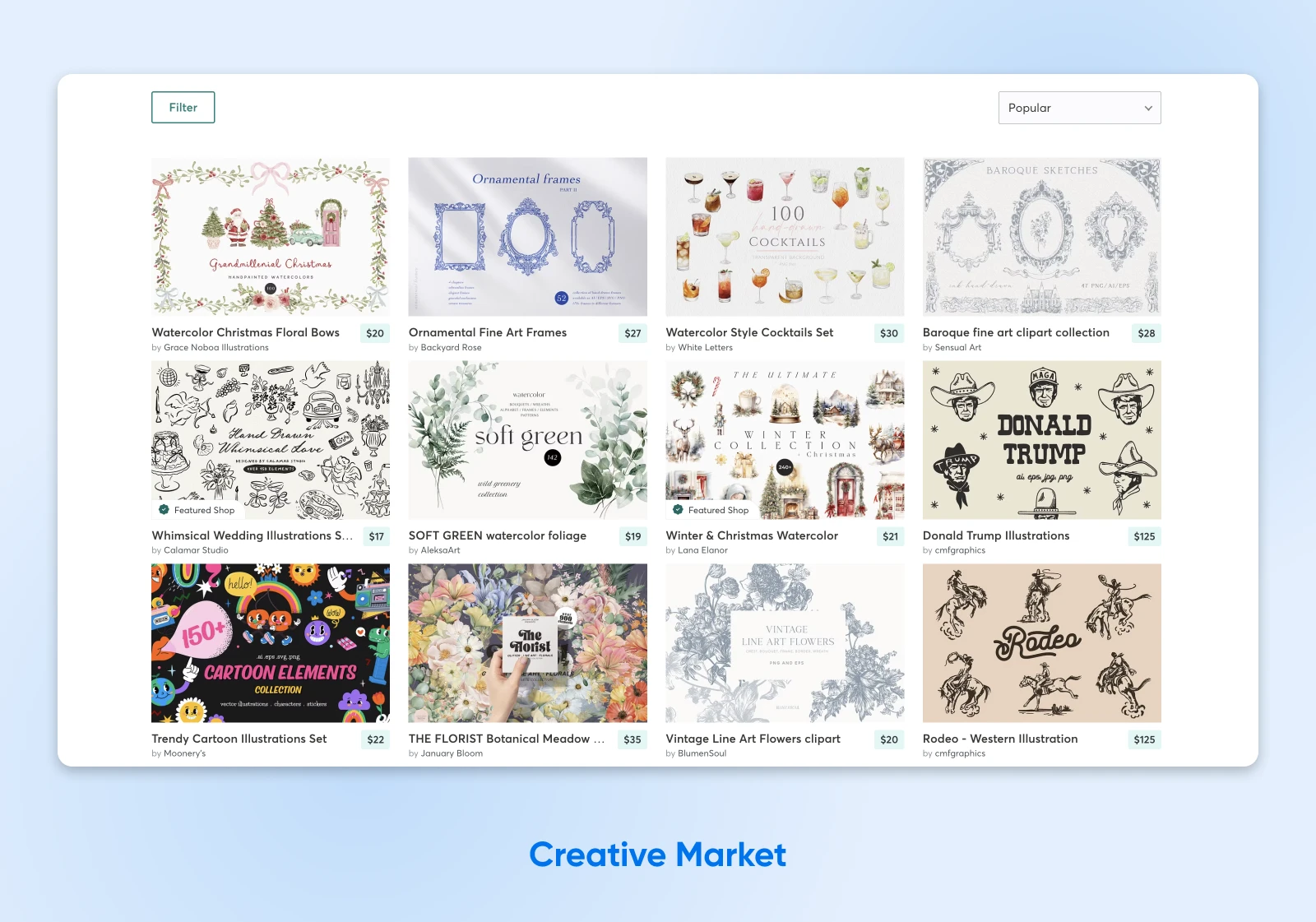
One photography seller on Reddit recommends Adobe Stock as their top option, followed by Shutterstock, Alamy, Getty Images, and 123RF.
Comment
byu/Art-A-Holic from discussion
inAskPhotography
For more ideas on creative online platforms like these, we found this list helpful.
What makes this such an ideal direction if you’re looking to get started selling today? Here are some of the benefits you can expect when you save time upfront by building your storefront on a site that already has many of the features artists need to move their digital work.
- Fast and easy set up: In most cases, you’ll be able to get your shop on these sites up and running with little time and no upfront cost or technical knowledge. Usually, you’ll just need to create a quick profile, set up how you’ll be paid out, and add your art to get started!
- Reach a “built-in” audience: Perhaps one of the best features of digital marketplaces is the built-in traffic from returning art-buying customers who are always looking for new work to add to their collections.
- Built-in marketing: As we’ll discuss soon, marketing is going to be key to reaching that magically matched audience who loves your work. Luckily, many art hosting platforms have at least some tools for boosting SEO, sending marketing emails, running sales, and even viewing your analytics so you can keep improving on these methods.
- Payments and delivery handled: It can be a lot to figure out how to legally collect money, handle taxes, and manage other payment intricacies for buyers around the world. Then there’s actually getting those precious digital files to buyers’ inboxes quickly and safely! Digital art selling platforms can take all of that off your hands.
On the flip side, we would be doing artists a disservice if we didn’t also detail some of the downsides of this approach. Watch out for things like…
- Increased competition: Even more than on the open web, on a digital art-specific platform, you have to stand out among tons of other artists all in one place. This is what makes it critical to know your niche.
- Fees: The exchange for getting more eyeballs on your art is almost always a fee from the host platform. Most often, they will take a percentage of each sale. Some also make money from transaction fees. As this can greatly impact your profit, this should be a critical shopping point when choosing your market.
- Way less control: Branding, delivery, customer service, analytical data — unfortunately, you don’t own any of that. This is perhaps one of the biggest reasons artists choose to move to a website where they can shape the world their digital art lives in.
Intermediate and Beyond: Create Your Own Website
Artists who have a good grasp on business and marketing and are tired of the fees, lack of control, and other downsides of digital marketplaces have another option:creating your own website!
Having helped approximately a million (give or take) DreamHost customers build websites over the years, we want to be upfront and mention that setting up an online store can be labor-intensive and time-consuming.
However, it’s overall an excellent choice for those who do have the resources. Here are just some of the reasons why:
- You get full control: Yes, full. You get to customize everything on your website, from the design to the branding, check out process, and customer experience from start to finish.
- Keep all your profits!: One of the most awesome benefits of selling on your website is getting to pocket all the money you make! Of course, if you use a payment processor, there are usually fees related to that, but it still feels a lot better than giving a faceless mega-platform a chunk of every hard-earned sale.
- Limitless marketing opportunities: Collect customer emails, track website behavior, and build smart, creative, and unique marketing campaigns with all the data flowing through your own website. No more valuable loyal client information fed into someone else’s marketing machine.
And now to bring us back down to earth just a bit, a few of the very real hangups you should know about before going all-in your own art website.
- Initial out-of-pocket costs: While you won’t be out fees for each sale for eternity (woohoo!), it’s pretty unlikely you’re going to set up a high-quality digital art sales website without incurring at least some initial fees (dang). Web hosting, use of a website platform, advanced marketing tooling, and a customized domain — all of these great website features come at a cost.
- Setup and ongoing maintenance take time: Naturally, creating your own website requires much more time, and there’s always ongoing maintenance associated with keeping it up to date and secure.
While there is certainly some time and cost associated with getting a custom artist website off the ground, thankfully, the technical learning curve has all but been taken care of. There are a few different ways you can skip most of the more technical elements of this process.
3. Get Smart(er) With Thoughtful Marketing
Now, to deliver on our earlier promise that you don’t have to be an influencer or have thousands of followers to create and sell your digital art online. But what you do have to be is will to invest time in smart promotion. Just uploading your art and hoping buyers will find it is not enough to make it in the modern competitive landscape.
Here are some more unique angles to market your work effectively, even when you’re starting with a smaller audience.
Speak Your Audience’s Language
Today, on the internet as a whole as well as any kind of sales platform, knowing the language shoppers use to search is critical. This is what the whole concept of SEO is predicated on.
To find out how your audience searches, you need to conduct keyword research.
Using a platform such as Google Keyword Planner, Semrush, or AnswerThePublic, start typing in phrases related to what you’re selling. These tools will help you figure out which phrases have a decent balance of competitiveness and volume, so you know your chances of showing up toward the top of a searcher’s results. They will often also give you more related ideas to target.
When you’ve identified a handful of phrases you want to be known for, start using those everywhere you can in your art titles and descriptions, website pages and blogs, and even on social media. This strategy helps you overcome the popularity contest and rise to the top when folks are shopping around for exactly what you’re selling.
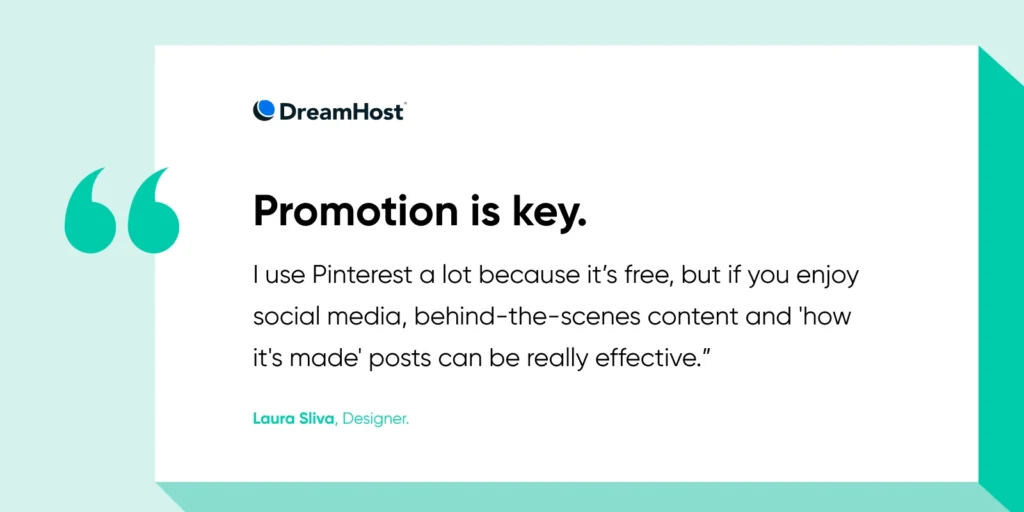
For a much more detailed walkthrough of everything you can do to improve your social media marketing prowess, don’t miss How To Create a Winning Social Media Strategy (A Comprehensive Guide).
And keep in mind many of the large online art marketplaces also have their own unique SEO tools and tricks, so don’t forget to look into how to optimize your listings on each. For example, here’s Etsy’s SEO guide.
Engage With the Few, Not the Many
This might seem a little counterintuitive but you don’t need thousands of followers to be successful!
What actually matters most is having a dedicated group of people who truly love and support your work, regularly.
That’s why so many of our business-building tips come back to one point: building real relationships.
So reply to those comments, send thank-you messages to buyers, create the content they love to engage with. While these aren’t traditional marketing tactics per say, these small, authentic interactions may add up to more repeat buyers and organic word-of-mouth traffic than any expensive ad campaign or time-consuming content marketing plan.
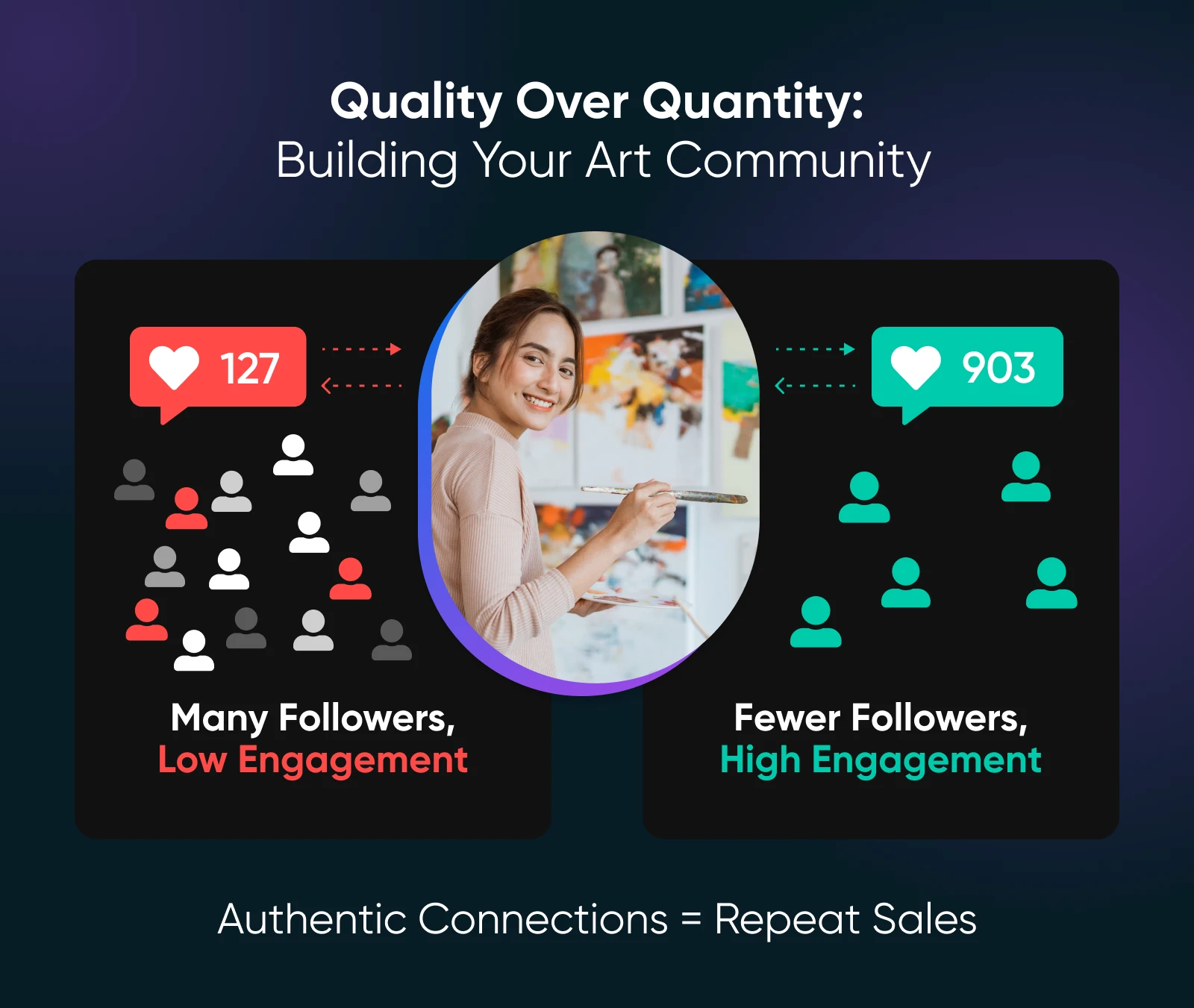
Create Content That Goes Above and Beyond
Don’t focus on going viral. Because chances are, you aren’t going to win that race if there are large influencers selling in the same space as you.
Instead, focus on delivering value as one of your core marketing tenants.
You want to develop content that gives people a reason to connect with you and your art. And it never hurts to create content that’s also useful at the same time.
This could mean videos showing your process, blogs offering tips or tutorials, or simple chatty short-form content about what inspires your work. Content like this builds trust, showcases your personality, and helps potential buyers feel a connection that keeps you top of mind when it comes time to purchase art next holiday season!
The great news is content in this category is even more impactful when it feels natural, so no need to invest in a huge set up or tons of editing to make marketing that sticks.
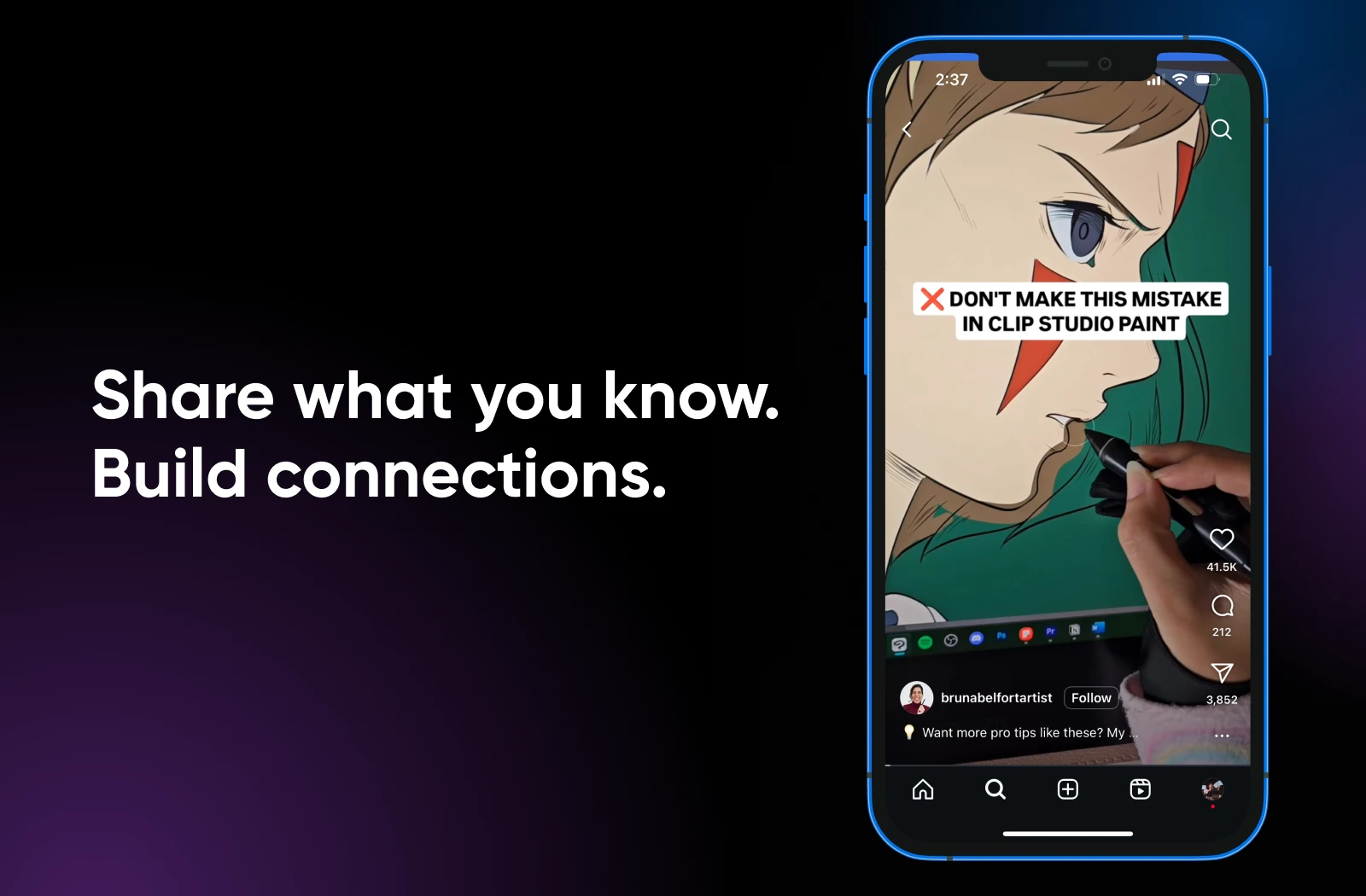
4. Keep ‘Em Coming Back With Great Customer Service
No matter where they come from and how you interact with them, it’s critical to take good care of your customers!
When you provide top-tier customer service and treat your customers well, they’re more likely to become repeat customers and even refer friends and family to you.
Great customer service doesn’t have to be complicated. Set realistic expectations around response times, then stick to them when shoppers need help. Find issue resolutions that work for everyone, clarify and live by the ethos of your brand, and always deliver your highest-quality work on time.
5. Protect Your Work (And Yourself)
There are a few additional measures online sellers should take to deter bad customers and make sure their work isn’t stolen or their brand diluted by scammers.
First, watermark all of your original art.
A watermark can discourage people from stealing your images because it makes it harder for them to be used without permission. It doesn’t have to be large or obtrusive, just enough to protect your work.
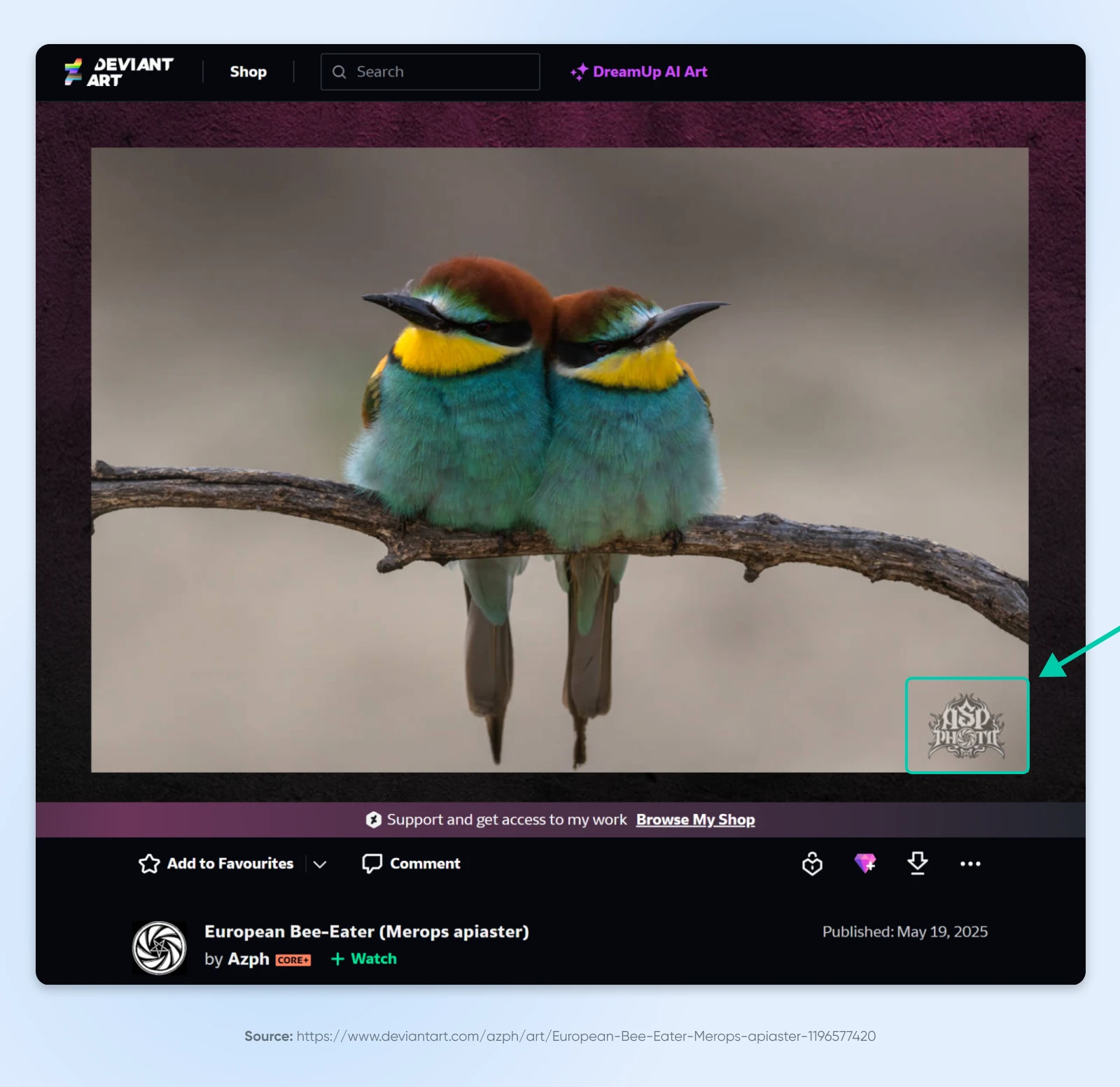
Also, include a copyright notice on your website and individual images and listings if possible. While it’s not totally necessary, this reminds people that your work is protected by law the moment you publish it.
Learn more about the ins and outs of copyrighting artwork here.
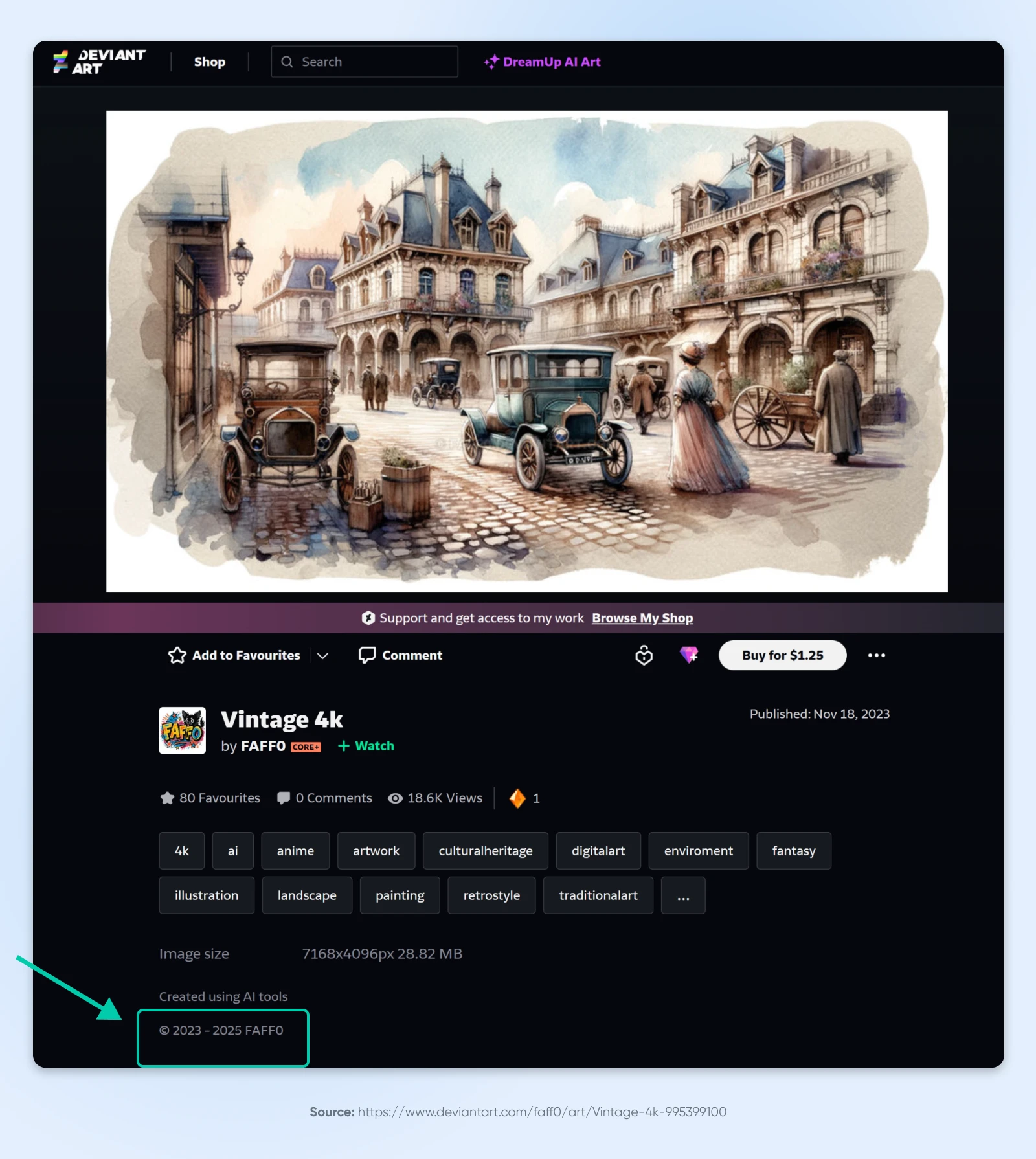
Finally, clearly state your terms of service. This should include your policies on refunds, exchanges, and personal use policies (such as what the buyer is allowed to do with your art).
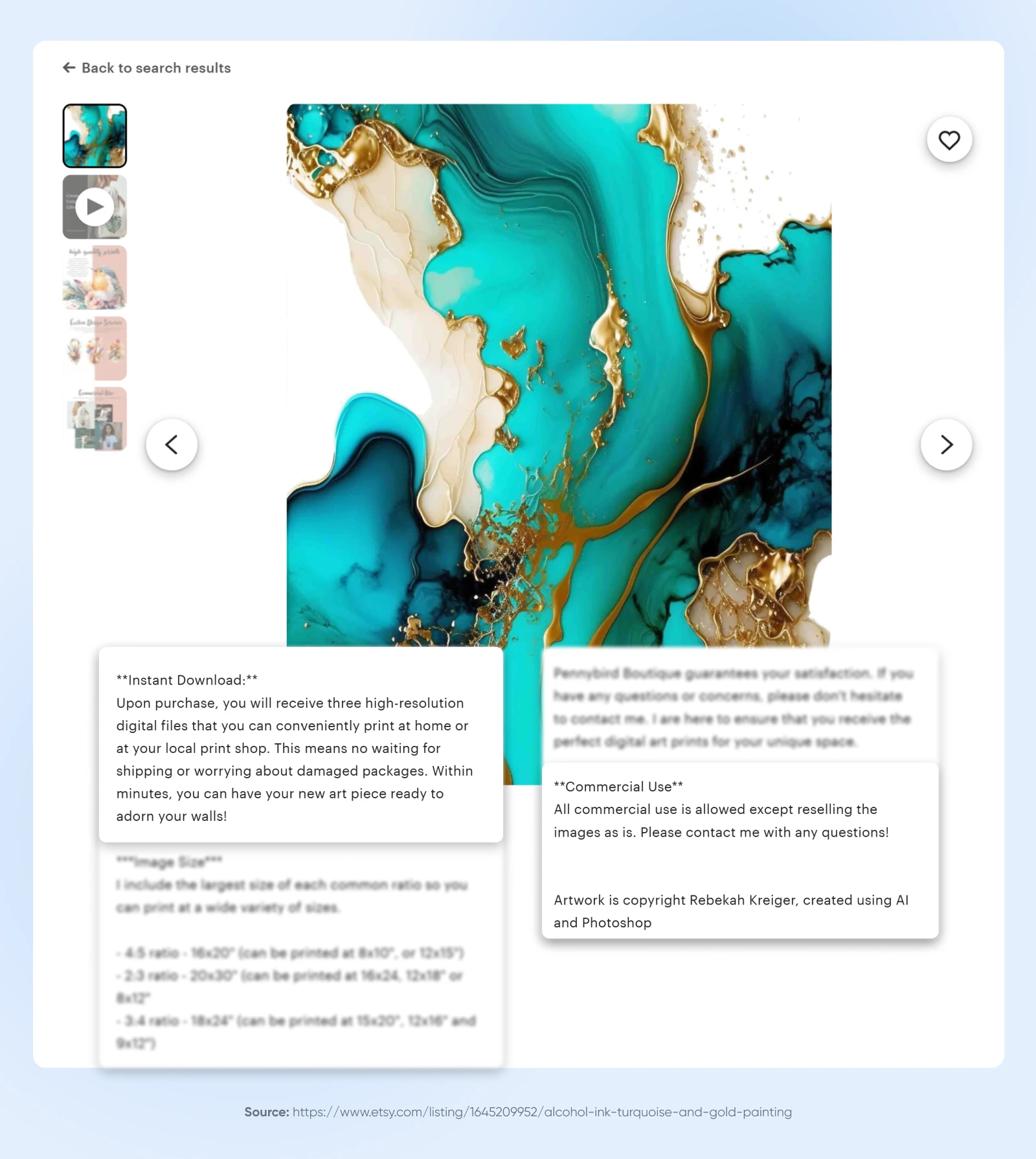
Growing Your Biz: Tips for Boosting Reach & Profits Selling Digital Art Online
The online art market has shown steady growth for years, and the type with the most growth potential is…digital art!
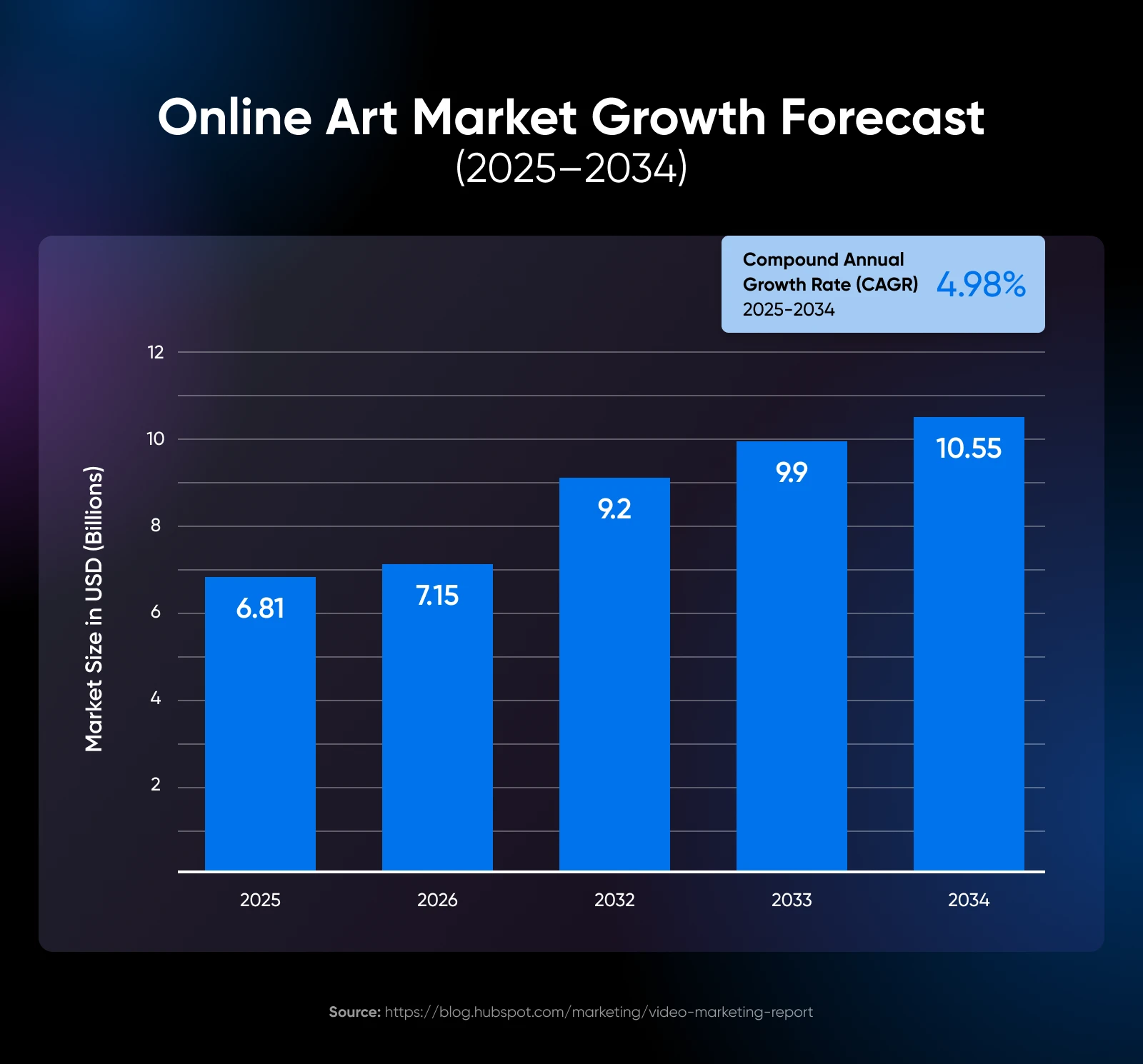
Simply put, more and more people are buying art online. So, it’s definitely possible to make money selling digital art.
Once your digital store is in full swing, try out the following approachable strategies to reach those buyers and boost your budding art biz.
Price It Right
Pricing art can be tricky, as there are a lot of variables to consider. Here are some factors that may influence how much you should charge.
- Time spent: Consider the time you spent creating the artwork. What would be a reasonable hourly rate for your work? This can be a helpful starting point.
- Your skill level: Artists with a high level of skill or years of experience can generally charge more for their work.
- Costs incurred: If there are any costs involved in creating the artwork, such as software subscriptions or hardware, these should be factored into the price.
- Market rates: Research what other artists with similar styles and experience levels are charging for comparable work. This can give you an idea of what customers might be willing to pay.
- Demand: The truth is, the more prized your art is, the more you can ask for.
To get started setting your prices, use this formula:
Base price = (hourly rate × hours worked) costs
Now, you have a number to start with that you can adjust based on your experience, your audience, and what you’re seeing sell in your space.
It’s important you revisit your pricing regularly. If you’re noticing increased traffic and purchases, try seeing if the market will bear higher pricing. But if all that traffic is passing on your art? It may be time to double-check that your pricing is in line with shopper expectations.
Even when you can’t necessarily raise your prices, increasing your efficiency as an artist and getting better and better at nailing all the moving elements of pricing should increase your take-home pay over time.
Stay Abreast of Diverse Products, Services, & Trends
Just like most internet-based businesses, digital artists looking to grow income and reach need to stay flexible and open to change.
The digital art world evolves quickly, so pay attention to what’s trending and how you can pivot your marketing and your offers to take advantage. You can do this by checking out hashtags on social media platforms like #digitalart and seeing what’s selling on your favorite art-selling platforms.
But, of course, you can’t just change up your entire art style to jump on every trend that comes along. Another way to diversify and get in front of more potential buyers is to consider how else you can make your art available via different services and products.
If you already do digital downloads, what if you worked with a platform like Redbubble to help you turn your creations into art prints or clothing designs for buyers?
And in addition to selling finished work, have you considered commissions, or recording elements of your process and selling online tutorials?
Comment
byu/maquis_00 from discussion
inartbusiness
Each new avenue taps into a different kind of buyer, which is how diversifying helps increase both visibility and revenue.
The Art of the Sale is in Your Hands
Whether you’re listing your first piece on a marketplace or building a full-fledged brand from your own website, it’s possible to become a successful artist without going viral or being glued to your phone around the clock.
Success in this arena is going to require time, patience, and most of all a focus on connecting with the right people.
And it starts with a place to sell.
DreamHost has options so you can build an online store yourself using Ecwid or WooCommerce. In addition, our Liftoff Website Builder uses AI to make this process even faster.
For a more white glove experience, you can also engage our professional services team to create a custom, fully-featured WordPress site to sell your art.
And remember: you don’t need a million followers. Show up consistently, connect with the right people, and keep creating work you believe in. That’s how a sustainable digital art business starts — and grows.

Online Store
Build Your Dream Store in Minutes
Sell anything, anywhere, anytime with confidence through DreamHost’s powerful e-commerce solutions. Choose between beginner-friendly Ecwid or fully customizable WooCommerce, both backed by DreamHost’s reliable hosting, 24/7 expert support, and money-back guarantee.
Learn More
